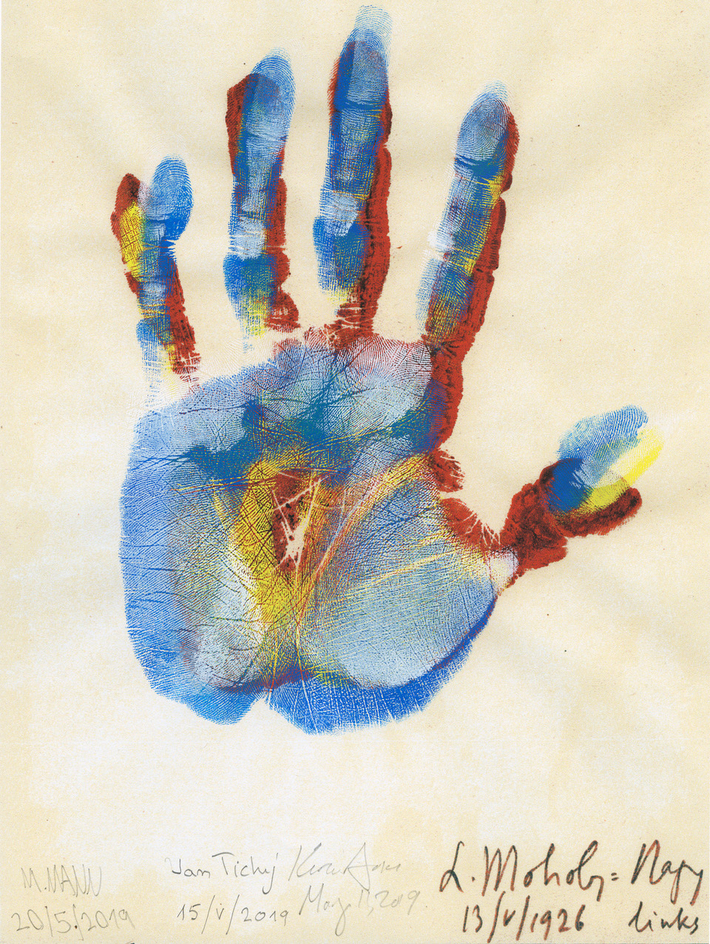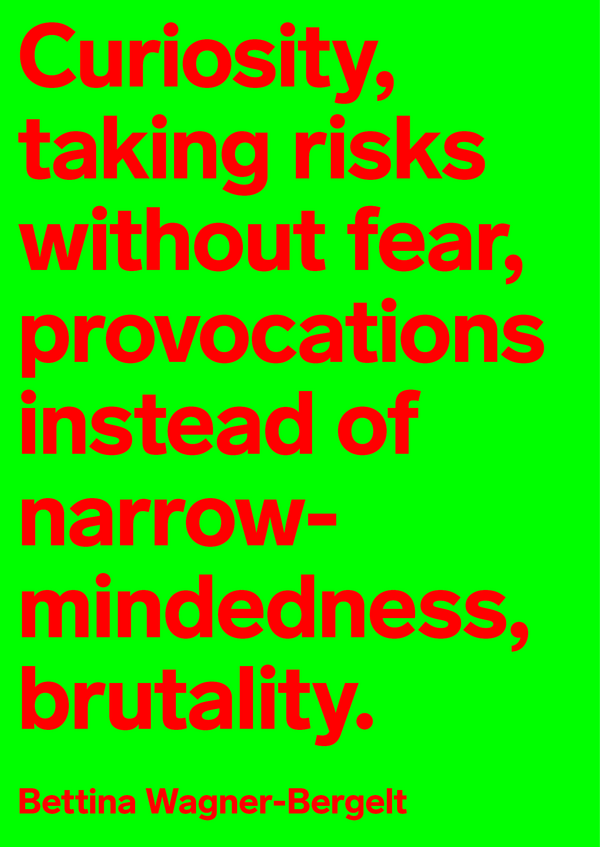This one school, it's still resonating
More voices on 100 years of bauhaus
Has the Bauhaus left behind a trail of light, like the task of the foundation-course exercise at the university in Weimar? We asked eight friends, critics, organisers and participants of the Bauhaus centenary to provide a brief summary.

Monika Grütters (CDU)
Federal Government Commissioner for Culture and the Media
The Bauhaus centenary has shown that even 100 years after its foundation, many ideas of the Bauhaus have remained modern and inspired generations of artists to this day. The motto “Thinking the Worls Anew” was like a thread through the diverse events, exhibitions and projects during the anniversary year. One of the highlights is the “Grand Tour of Modernity”, leading throughout Germany on attractive journeys to 100 important cultural- historical buildings, for which it was my pleasure to act as patron. The fact that so many people were inspired, above all young people, by the international project “bauhaus imaginista” at the Haus der Kulturen der Welt in Berlin, once again shows the timeless fascination of the Bauhaus movement.
The Bauhaus centenary has left its traces – also among many people who may have engaged with the influential school for the first time. One visible sign is the opening of two new Bauhaus museums in Dessau and Weimar with funds from the Federal Government, together with the respective states. The Berlin building is next. Broadly spread educational programmes that can build on the projects by the “Bauhaus Agents” are further sustainable effects of the anniversary year. I am particularly pleased that the intensive study of the Bauhaus has led to a new assessment of the role of women there, since they have been sorely neglected by the history books in the past.
I would like to warmly thank everyone who contributed their inventiveness, commitment and persistence to ensure the success of this centenary.
Antje Horn
Project Manager, Grand Tour of Modernity
Already in the Renaissance period, the grand tour was a great educational experience. People visited art locations, viewed buildings and monuments, explored landscapes and learned more about the country and its people. As part of the Bauhaus centenary, we reinvented the experience of a Grand Tour of Modernity. Our Grand Tour includes locations that stand in the field of tension between Modernity and the Bauhaus. The underlying principle is to integrate exceptional architectural examples into the context of German architectural Modernity in the 20th century.
The buildings included in the Grand Tour of Modernity are not only in major cities and not just found in places where the Bauhaus was directly situated. Instead, the list ranges from Hamburg to Stuttgart, from Niesky to Kindenheim, and from Krefeld to Cottbus. You can continue to use our website grandtourofmodernism.com after the centenary year 2019 to discover more locations and their history. Create your own Grand Tour of Modernity and set off on your journey. I hope you enjoy retracing routes you know and discovering as yet unfamiliar paths.
Zitat Roth

Klaus Lederer (Die Linke)
Mayor and Senator for Culture and Europe of the State of Berlin
It was clear that the centenary year would be a success in view of the work, enthusiasm and energy that everyone involved contributed, which is very pleasing. The actual extent of the success was a further positive surprise to me. That speaks for the timelessness of the idea of merging art and technology, for aspiring to make life better and more beautiful for as many people as possible, and naturally for the radiance of design.
It was an anniversary year in which we all did justice to the Bauhaus on so many levels and in all of its facets: from its political relevance to contemporary times to the countless participation offers and wonderful exhibitions.
Marion von Osten
Curator of bauhaus imaginista
The project bauhaus imaginista has been internationally active since 2018, with exhibitions and events in Rabat, Hangzhou, New York, Kyoto, Tokyo, Moscow, Sao Paulo, Lagos, New Delhi, Berlin, Bern and Nottingham. In 2020, it is now opening its final stage with SALT in Istanbul. The constant international interest in this project speaks for strong international partnerships, as well as the necessity to locate Bauhaus Modernity on a global scale today.
Already, the feedback from various stages and the online journal bauhaus-imaginista.org tell us that bauhaus imaginista during the centenary year represents a paradigmatic starting point to investigate the Bauhaus and its worldwide resonance in a different way.
Zitat Wagner-Bergelt

Rainer Robra (CDU)
Minister of State and Head of the Chancellery Office of the State of Saxony-Anhalt, Minister of Culture and Europe
The Bauhaus centenary was both a forum and a driving force behind important artistic and social debate. The outstanding work of Gropius, Kandinsky, Feininger and other pioneering thinkers was celebrated with ideas, creativity and great joy. I am very pleased that so many different participants contributed to the success of the celebrations.
The many cooperative partnerships have led to new, stable and global networks that will continue to exist beyond the anniversary year. The Bauhaus legacy has not come to an end after 2019. Instead, the centenary is the starting point for further activity. The Bauhaus remains lively and its stories are far from over. Furthermore, the question of the shape of modern thinking in the future remains relevant.
Claudia Roth (Alliance 90/The Greens)
Vice President, German Bundestag
Celebrations marking 100 years of the Bauhaus began very early in the German Bundestag, namely in 2015, when we decided to provide special budget funds for the anniversary. This not only expedited the extensions to the Bauhaus Museums in Dessau and Weimar, but also highlighted one aspect through numerous events and exhibitions: the Bauhaus idea comprises much more than architecture and design. It is also a history of democracy.
The fact that between 1919 and 1933, there were around 450 women among over a thousand Bauhaus students has hardly been noticed for a long time. As we know today, a number of them were responsible for the most economically successful development of all. Let us name them personally: Gunta Stölzl, Anni Albers, Benita Otte, Otti Berger, Alma Siedhoff- Buscher, Friedl Dicker, Marguerite Friedlaender-Wildenhain and Marianne Brandt. They too were and remain part of the Bauhaus – on a par with Walter Gropius, László Moholy-Nagy, Hannes Meyer and Ludwig Mies van der Rohe.
The Bauhaus was groundbreaking on a wide range of levels: completely new working methods and an end to the distinction between art and craftsmanship, between theory and practice, the combination of different crafts to form a unity, and the courage to think in completely new ways. Studies that created a community with dance, theatre, readings, music and costume parties, a community that focused on diversity and a joy of experimentation, that attempted to leave hierarchical thinking behind – all that was new and different. Too different for the National Socialist dictatorship, which soon began to take a grip on Germany. Thus the Bauhaus was forced to close in 1933, only 14 years after its foundation. The idea of the freedom of art ended as the Nazis took power. But only temporarily, since the Bauhaus survived in the minds of those in exile.
This one school, it's still resonating! 100 years of the Bauhaus means far more than simply a retrospective. Culture as a social project can still be rethought today. The Bauhaus therefore remains a vision, an inspiration and a discourse in a world with a climate crisis and conflicts, a world full of enemies of democracy and the constitutional state – in an ever more complex world that finds a perspective counterpart in the uncomplicated, reduced, elegant and sustainable Bauhaus functionalism.
Last but not least, the enthusiastic visitors to the countless exhibitions and events during the centenary year have shown that interest in the Bauhaus has not diminished even a hundred years after its foundation. My interim summary? It seems to be worthwhile to forge ahead and think differently. How comforting, Bauhaus, how inspiring!
Zitat Grütters

Jan Tichy
Artist, educator and curator "Ascendants: the Bauhaus Handprints"
The Bauhaus Centennial created an important space in time to re-examine parts of our own history on a global level. This experience of global acknowledgment and reflection was at times overwhelming but crucial for deeper understanding and honest relationship with the Bauhaus legacy.
I have dedicated the centennial year to artistically explore and continue the Bauhaus Handprints project based on a set of handprints created by thirteen Bauhaus masters and students in May 1926 in Dessau and collected by Laszlo Moholy-Nagy. Working closely with the Moholy-Nagy estate, I was able not just to reproduce the historical artifacts but collaboratively develop them into a new material with three groups of students from art schools in Chicago (USA); Modena (IT) and Hradec Kralove (CZ).
The process resulted in four exhibitions in Germany and Chicago and are accompanied by a publication co-edited with Dr. Robin Schuldenfrei and published by Institute of Design in Chicago. We hope that this publication will join the many important documents published within the framework of the Centennial and contribute to wider understanding of Bauhaus and its relevancy today.
Bettina Wagner-Bergelt
100 years of bauhaus opening festival's artistic director and director of the Tanztheater Wuppertal Pina Bausch
Interacting with the art of the Bauhaus has once again inspired me open up to questions, research, experimentation, incomplete aspects and the process itself, and focus less on perfect results. That is where the charm of the Bauhaus stage, its artists, music and dance, lies. It is combined with an attitude to life that is now under threat from right-wing forces: openness, curiosity, taking risks without fear, also provocations, striving forward to the essence, instead of petty national thinking, narrow-mindedness, dullness, brutality and baseness.
[NF 2020]
![[Translate to English:]](/fileadmin/_processed_/b/e/csm_Bauhaus_Now_1_Cover_dadd8d2735.png)

